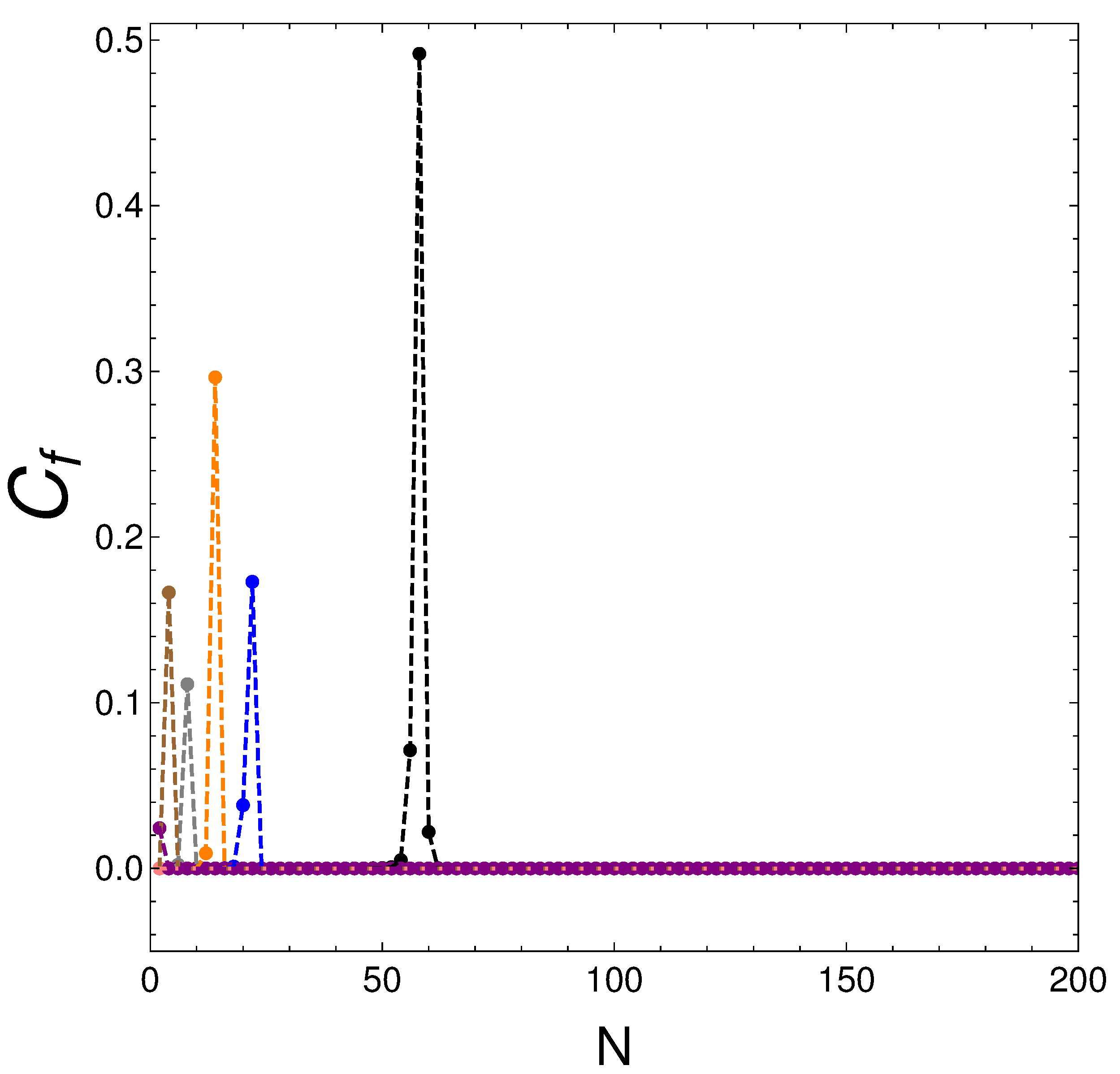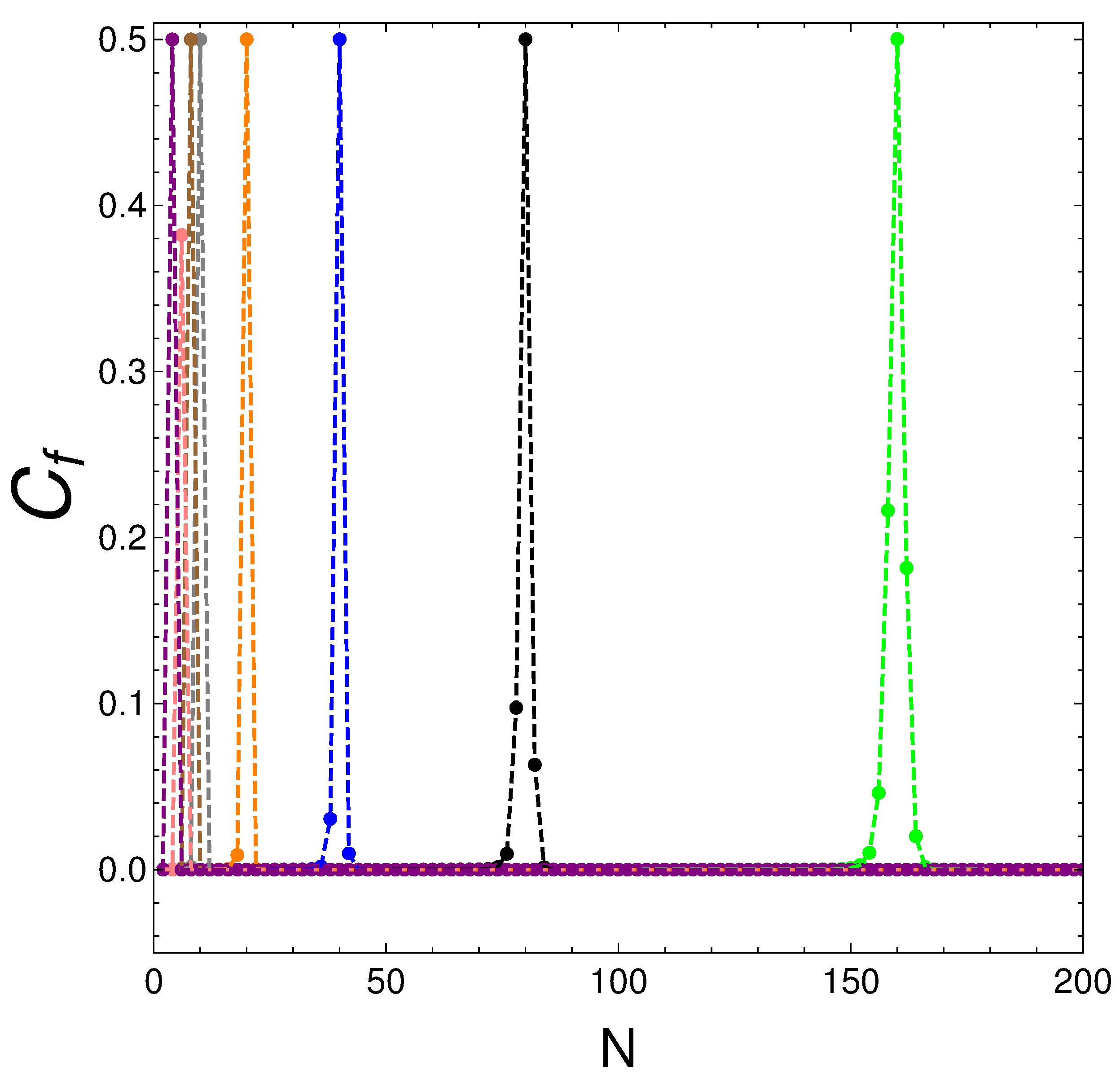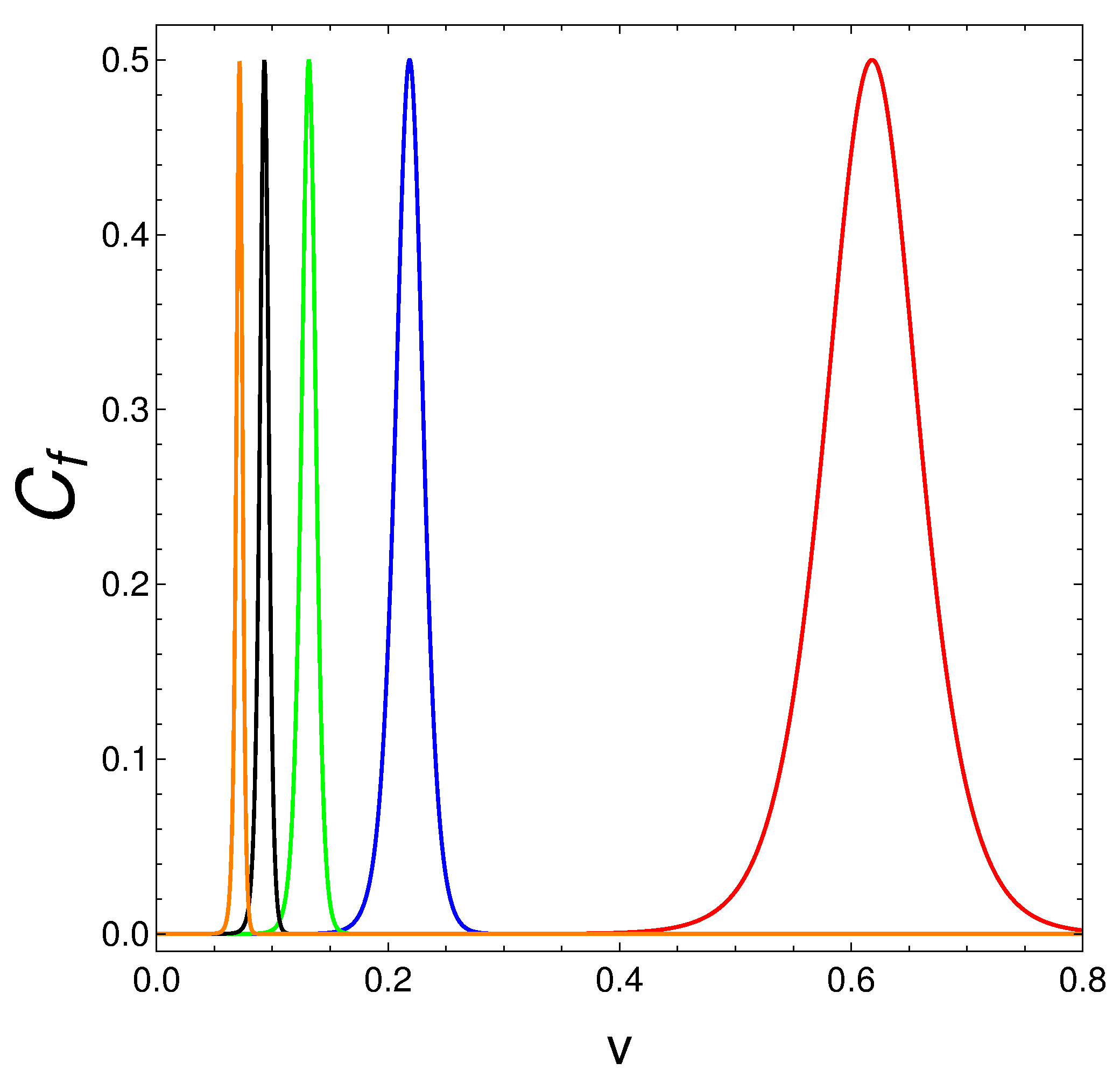Magic Numbers and Mixing Degree in Many-Fermion Systems
Abstract
1. Introduction
Present Goal
2. Preliminaries
2.1. Quantum Mixing-Degree Quantifier
2.2. Usefulness of Exactly Solvable Many-Body Systems
- Insight into quantum phenomena: Exactly solvable many-body systems often serve as simple and tractable models that exhibit essential quantum phenomena, such as quantum phase transitions, entanglement, and quantum correlations. They provide valuable intuition and understanding of fundamental quantum concepts.
- Testing quantum theories: Because these systems are analytically solvable, they are ideal for testing and validating theoretical methods and approximations used in more complicated systems. They allow researchers to check the accuracy and efficiency of numerical algorithms and analytical techniques.
- Educational tools: Exactly solvable many-body systems are commonly used as educational tools in teaching quantum mechanics and statistical physics. They provide students with concrete examples to illustrate abstract concepts and principles.
- Foundation for approximations: Many-body systems that are exactly solvable often serve as the foundation for developing approximate methods applicable to more complex systems. These methods include mean-field theory, perturbation theory, and variational approaches.
- Condensed matter physics: Exactly solvable models play a crucial role in understanding phase transitions and critical phenomena in condensed matter physics. They shed light on the emergence of collective behaviors in large systems.
- Quantum information theory: Solvable models are essential in quantum information theory, particularly in studies related to quantum computing, quantum error correction, and quantum communication protocols.
- Benchmarking numerical techniques: Exactly solvable models provide precise results that can be used as benchmarks to assess the accuracy and efficiency of numerical techniques, such as Monte Carlo simulations, tensor network methods, and a density-matrix renormalization group (DMRG).
2.3. Using Very Low Temperature Statistical Mechanics Techniques to Approximate Ground-State Properties
2.4. Magic Numbers in Many-Fermion Systems
2.5. Expanding on Our Present Objectives
3. The AFP Model Structure
3.1. Quasi-Spin Operators
3.2. The AFP Model
4. Working within the Gibbs Ensemble Framework
A State’s Degree of Mixture
5. Present Results for Our Main Quantifier
5.1. Results as a Function of the Particle Number
5.2. Energetic Interpretation of the
5.3. Results as a Function of the Coupling Constant v
5.4. Effects of the Peaks on Macroscopic Quantities
6. Conclusions
Author Contributions
Funding
Data Availability Statement
Acknowledgments
Conflicts of Interest
Appendix A. Our Hamiltonian Matrix
References
- Tsallis, C. Possible generalization of Boltzmann-Gibbs statistics. J. Stat. Phys. 1988, 52, 479–487. [Google Scholar] [CrossRef]
- Gell-Mann, M.; Tsallis, C. Nonextensive Entropy: Interdisciplinary Applications; Oxford University Press: Oxford, UK, 2004. [Google Scholar]
- Tsallis, C. Entropy. Encyclopedia 2022, 2, 264–300. [Google Scholar] [CrossRef]
- Tsallis, C. The nonadditive entropy Sq and its applications in physics and elsewhere: Some remarks. Entropy 2011, 13, 1765–1804. [Google Scholar] [CrossRef]
- Tsallis, C. Beyond Boltzmann-Gibbs-Shannon in physics and elsewhere. Entropy 2019, 21, 696. [Google Scholar] [CrossRef]
- Sánchez Almeida, J. The principle of maximum entropy and the distribution of mass in galaxies. Universe 2022, 8, 214. [Google Scholar] [CrossRef]
- Tsallis, C. Introduction to Nonextensive Statistical Mechanics—Approaching a Complex World, 2nd ed.; Springer: Berlin/Heidelberg, Germany, 2023. [Google Scholar]
- Curilef, S. On the generalized Bose-Einstein condensation. Phys. Lett. A 1996, 218, 11–15. [Google Scholar] [CrossRef]
- Tirnakli, U.; Buyukkilic, F.; Demirhan, D. Some bounds upon the nonextensivity parameter using the approximate generalized distribution functions. Phys. Lett. A 1998, 245, 62. [Google Scholar] [CrossRef]
- Uys, H.; Miller, H.G.; Khanna, F.C. Generalized statistics and high—Tc superconductivity. Phys. Lett. A 2001, 289, 264. [Google Scholar] [CrossRef]
- Conroy, J.M.; Miller, H.G. Color superconductivity and Tsallis statistics. Phys. Rev. D 2008, 78, 054010. [Google Scholar] [CrossRef]
- Silva, R.; Anselmo, D.H.A.L.; Alcaniz, J.S. Nonextensive quantum H-theorem. Europhys. Lett. 2010, 89, 10004. [Google Scholar] [CrossRef][Green Version]
- Biro, T.S.; Shen, K.M.; Zhang, B.W. Non-extensive quantum statistics with particle-hole symmetry. Phys. A 2015, 428, 410. [Google Scholar] [CrossRef][Green Version]
- Deppman, A.; Megias, E.; Menezes, D.P. Fractal Structures of Yang-Mills Fields and Non-Extensive Statistics: Applications to High Energy Physics. Physics 2020, 2, 455–480. [Google Scholar] [CrossRef]
- Bengtsson, I.; Zyczkowsi, K. Geometry of Quantum States: An Introduction to Quantum Entanglement; Cambridge University Press: Cambridge, UK, 2006. [Google Scholar]
- Jaeger, G. Qantum Information: An Overview; Springer: Berlin/Heidelberg, Germany, 2007. [Google Scholar]
- Lipkin, H.J.; Meshkov, N.; Glick, A.J. Validity of many-body approximation methods for a solvable model: (I). Exact solutions and perturbation theory. Nucl. Phys. 1965, 62, 188. [Google Scholar] [CrossRef]
- Co’, G.; De Leo, S. Analytical and numerical analysis of the complete Lipkin–Meshkov–Glick Hamiltonian. Int. J. Mod. Phys. E 2018, 27, 5. [Google Scholar] [CrossRef]
- Plastino, A.R.; Monteoliva, D.; Plastino, A. Information-theoretic features of many fermion systems: An exploration based on exactly solvable models. Entropy 2021, 23, 1488. [Google Scholar] [CrossRef] [PubMed]
- Otero, D.; Proto, A.; Plastino, A. Surprisal Approach to Cold Fission Processes. Phys. Lett. B 1981, 98, 225. [Google Scholar] [CrossRef]
- Satuła, W.; Dobaczewski, J.; Nazarewicz, W. Odd-Even Staggering of Nuclear Masses: Pairing or Shape Effect? Phys. Rev. Lett. 1998, 81, 3599. [Google Scholar] [CrossRef]
- Dugett, T.; Bonche, P.; Heenen, P.H.; Meyer, J. Pairing correlations. II. Microscopic analysis of odd-even mass staggering in nuclei. Phys. Rev. C 2001, 65, 014311. [Google Scholar] [CrossRef]
- Ring, P.; Schuck, P. The Nuclear Many-Body Problem; Springer: Berlin/Heidelberg, Germany, 1980. [Google Scholar]
- Kruse, M.K.G.; Miller, H.G.; Plastino, A.R.; Plastino, A.; Fujita, S. Landau-Ginzburg method applied to finite fermion systems: Pairing in nuclei. Eur. J. Phys. A 2005, 25, 339. [Google Scholar] [CrossRef]
- de Llano, M.; Tolmachev, V.V. Multiple phases in a new statistical boson fermion model of superconductivity. Phys. A 2003, 317, 546. [Google Scholar] [CrossRef]
- Xu, F.R.; Wyss, R.; Walker, P.M. Mean-field and blocking effects on odd-even mass differences and rotational motion of nuclei. Phys. Rev. C 1999, 60, 051301. [Google Scholar] [CrossRef]
- Häkkinen, H.; Kolehmainen, J.; Koskinen, M.; Lipas, P.O.; Manninen, M. Universal Shapes of Small Fermion Clusters. Phys. Rev. Lett. 1997, 78, 1034. [Google Scholar] [CrossRef]
- Hubbard, J. Electron Correlations in Narrow Energy Bands. Proc. R. Soc. Lond. 1963, 276, 237. [Google Scholar]
- Liu, Y. Exact solutions to nonlinear Schrodinger equation with variable coefficients. Appl. Math. Comput. 2011, 217, 5866. [Google Scholar] [CrossRef]
- Frank, R. Quantum criticality and population trapping of fermions by non-equilibrium lattice modulations. New J. Phys. 2013, 15, 123030. [Google Scholar] [CrossRef]
- Lubatsch, A.; Frank, R. Evolution of Floquet topological quantum states in driven semiconductors. Eur. Phys. J. B 2019, 92, 215. [Google Scholar] [CrossRef]
- Feng, D.H.; Gilmore, R.G. Self-organized criticality in a continuous, nonconservative cellular automaton modeling earthquakes. Phys. Rev. C 1992, 26, 1244. [Google Scholar] [CrossRef]
- Bozzolo, G.; Cambiaggio, M.C.; Plastino, A. Maximum Overlap, Atomic Coherent States and the Generator Coordinate Method. Nucl. Phys. A 1981, 356, 48. [Google Scholar] [CrossRef]
- Monteoliva, D.; Plastino, A.; Plastino, A.R. Statistical Quantifiers Resolve a Nuclear Theory Controversy. Q. Rep. 2022, 4, 127–134. [Google Scholar] [CrossRef]
- Reif, F. Fundamentals of Statistical Theoretic and Thermal Physics; McGraw Hill: New York, NY, USA, 1965. [Google Scholar]
- Pennini, F.; Plastino, A. Thermal effects in quantum phase-space distributions. Phys. Lett. A 2010, 37, 1927–1932. [Google Scholar] [CrossRef]




| Color Line | v | ||||
|---|---|---|---|---|---|
| Black | 0.01 | 58 | 0.1629 | 0.0129 | 0.2243 |
| Blue | 0.03 | 22 | 0.1959 | 0.1123 | 0.5503 |
| Orange | 0.05 | 14 | 0.2689 | 0.0755 | 0.6447 |
Disclaimer/Publisher’s Note: The statements, opinions and data contained in all publications are solely those of the individual author(s) and contributor(s) and not of MDPI and/or the editor(s). MDPI and/or the editor(s) disclaim responsibility for any injury to people or property resulting from any ideas, methods, instructions or products referred to in the content. |
© 2023 by the authors. Licensee MDPI, Basel, Switzerland. This article is an open access article distributed under the terms and conditions of the Creative Commons Attribution (CC BY) license (https://creativecommons.org/licenses/by/4.0/).
Share and Cite
Monteoliva, D.; Plastino, A.; Plastino, A.R. Magic Numbers and Mixing Degree in Many-Fermion Systems. Entropy 2023, 25, 1206. https://doi.org/10.3390/e25081206
Monteoliva D, Plastino A, Plastino AR. Magic Numbers and Mixing Degree in Many-Fermion Systems. Entropy. 2023; 25(8):1206. https://doi.org/10.3390/e25081206
Chicago/Turabian StyleMonteoliva, D., A. Plastino, and A. R. Plastino. 2023. "Magic Numbers and Mixing Degree in Many-Fermion Systems" Entropy 25, no. 8: 1206. https://doi.org/10.3390/e25081206
APA StyleMonteoliva, D., Plastino, A., & Plastino, A. R. (2023). Magic Numbers and Mixing Degree in Many-Fermion Systems. Entropy, 25(8), 1206. https://doi.org/10.3390/e25081206







